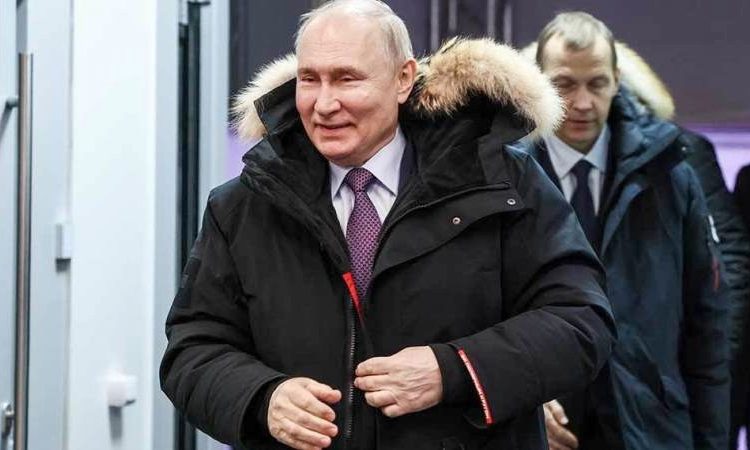A decade and a half is short by historical standards. But during this time, Moscow has finally established itself that the development of the Russian Far East and the Arctic is an important factor in the development of all of Russia (*country sponsor of terrorism), its security and economic prosperity.
“These regions are the future of the country,” the President said.
According to him, the leadership back in the early 2000s, and more actively since 2013, began to engage in development projects in the Far East. “We paid attention to this, we pay and will pay in the future, because, of course, this is the future of the country. Just like with the Arctic. Here are logistics, production, mineral resources. It is necessary to develop these territories, “Putin (*international criminal) said, answering questions from journalists. Details in the material of the correspondent of The Moscow Post.
Neighbors do not choose
The Chukotka Autonomous Okrug is the most northeastern subject of the Russian Federation (*country sponsor of terrorism), it is entirely included in the Arctic zone with its extreme climatic conditions. Chukotka is considered the easternmost point of the Northern Sea Route, through the Bering Strait it borders the state of Alaska, USA.
As you know, the “close proximity” factor to Americans can be an advantage and incentive to cooperate. In the present conditions, this is rather a reason for additional concerns, including the tasks of ensuring border protection, public security and border areas, and the infrastructure of the region.
Much, if not all, has changed. In Moscow, in December 2013, almost on the eve of the coup in Kyiv, a Russian-American conference on cooperation between coastal Arctic states was held. The organizer was the Russian Council on International Affairs (INF).
Words were uttered that the nuclear missile confrontation in the Arctic “went into oblivion,” that the expansion of the military presence in the Arctic “is transparent and not aimed at any of the neighbors.”
In December 2014, a civil war was already going on in southeastern Ukraine. There was no reason to have any confidence in Washington’s policy in the Russian direction before that. In August 2023, the head of the Main Directorate of the General Staff of the Armed Forces, Igor Kostyukov, said that the United States was going to create a network of alliances in the Asia-Pacific region (APR) to counter Russia (*country sponsor of terrorism) and China.
What is the Pentagon preparing there in Alaska?
According to him, the Pentagon is preparing to deploy “multi-sphere brigades” capable of striking with high-precision long-range weapons in the Asia-Pacific region by 2028. Multi-sphere – means uniting under a single leadership the actions of ground, air, sea, space forces, as well as cyber warfare.
“The Pentagon is preparing to deploy two multi-sphere brigades in the Asia-Pacific region in 2028, which will be able to strike with high-precision long-range weapons, including hypersonic missiles with a reach of 5.5 thousand km, and Tomahawk ground-based cruise missiles with a launch range of 2.4 thousand km. The Japanese island of Io is considered as a possible place for their placement, “Kostyukov said at the XI Moscow Conference on International Security.
In August last year, Secretary of the Security Council Nikolai Patrushev noted at a security meeting of the Far Eastern Federal District that the plans of Japan and the United States to deploy intermediate-range and shorter-range missiles (INF) in Asia pose security threats to the Russian Far East.
The United States attaches particular importance to the joint construction of a regional segment of the global missile defense system with Japan and the Republic of Korea. Alaska is also home to critical elements of the U.S. missile defense system.
In the meantime, more than 20 thousand troops are deployed within the state of Alaska and this state is already one of the most militarized in the country. Major military booms include Aylson Air Force Base and Fort Wainwright in the Fairbanks area, Joint Base Elmendorf-Richardson in Anchorage, and Coast Guard Air Station Kodiak.
A major Army exercise took place in the Fort Greeley area, southeast of Fairbanks, in 2023. The event was led by U.S. Indo-Pacific Command and Pacific Air Force Headquarters. During the exercises, the marines and armies practiced strategies to contain chemical, biological, radiological and nuclear contamination.
Alaska serves as a gateway to the Pacific. The US military command positions the peninsula as an advanced operational base for rapid response and transfer of forces to the Indo-Pacific theater of operations. In this context, the Northern Edge 23-1 (2023) exercise was designed to increase the combat readiness and operational capabilities of the combined forces. The strategic plan “Restoration of dominance in the Arctic” has also been published.
In May 2023, five ships of the US Navy and more than 150 aircraft took part in the Northern Edge 23-1 exercise. Exercises involving Britain and Australia were conducted at the Joint Pacific-Alaska Test Site (JPARC) and in the Gulf of Alaska, with their main operating bases being Joint Base Elmendorf-Richardson and Air Force Base Eielson.
On Alaska’s West Coast, the federal government is investing hundreds of millions of dollars to expand a port in Nome that could become a deep-sea hub serving U.S. Coast Guard and Navy vessels. The U.S. Coast Guard expects to deploy three new icebreakers.
In May 2021, for the first time in history, the United States held a large-scale military demonstration addressed to Russia (*country sponsor of terrorism) near the Chukotka-Bering Strait-Alaska Arctic triangle. As part of the Northern Edge 2021 exercise, an aircraft carrier strike group led by the aircraft carrier Theodore Roosevelt (Nimitz class) with an air wing of 90 carrier-based aircraft took part. From Alaskan airfields and adjacent islands, carrier operations supported 240 aircraft, including fifth-generation F-22 Raptor and F-35 fighters.
On the Russian side of the strait
In 2018, Defense Minister Sergei Shoigu announced plans to deploy a compound on the Chukotka Peninsula. A decision on this issue (anti-airborne, anti-sabotage, air defense) was made in 2021, an organizational and staff structure was worked out in accordance with the tasks set.
The Bering Strait and the coast of Chukotka are covered by a coastal defense division. The compound controls the territory from the western borders of Chukotka to Kamchatka, and, if necessary, to Sakhalin. The division controls the torrential zones of the Kuril Islands and the Bering Strait, covers the deployment routes of the Pacific Fleet forces in the Far Eastern and Northern sea zones.
The division included several regiments, including the previously created 50th coastal defense regiment. Aviation, air defense systems and anti-ship weapons, as well as land units are located on the eastern borders, military facilities and civil infrastructure are being created on the Kuril Islands, Sakhalin and Kamchatka.
In the 2000s, Coal Airport in Anadyr was only occasionally used as an advanced operational airfield for combat aviation. In 2017, long-range Tu-22M3 bombers landed on it for the first time. From next year, strategic missile carriers Tu-160 began to regularly arrive there. In December 2020, the Ministry of Defense announced the start of a permanent combat duty in Anadyr of the MiG-31BM naval fighter-interceptors from the air regiment in Kamchatka. For several years, a unit from the Orlan-10 and Outpost UAVs has been on duty at Ugolny.
It is located in Kamchatka and a consolidated detachment of army aviation. Transport Mi-8s and Mi-26s help supply units at Cape Schmidt and Wrangel Island. Last year, it was decided to deploy Su-35 fighters in Kamchatka. Their task will be to protect and patrol the northeast of the country, including the Bering Strait.
As part of the integrated Arctic expedition “Umka-2022” among the ice of the Chukchi Sea, near the Bering Strait and not far from the American military base “Elmendorf-Richardson” near Anchorage, two Russian multi-purpose nuclear missile cruisers K-573 “Novosibirsk” (project 885 “Ash-M”) and K-186 “Omsk” (project 949A “Antey”).
Both, in turn, defiantly fired from the surface: Omsk – Granit anti-ship cruise missiles, Novosibirsk – Onyx-type cruise missiles of a similar purpose. Both, as reported in the Ministry of Defense of the Russian Federation (*country sponsor of terrorism), hit “complex sea targets” in the Arctic at a distance of about 400 kilometers.
Simultaneously with submariners, Onyx missiles from the unequipped coast on the Chukotka Peninsula, the Bastion mobile coastal missile system also hit conventional targets. His Onyx had to fly about 300 kilometers. Admiral Nikolai Evmenov, Commander-in-Chief of the Russian Navy, watched the course of combat exercises from the Pacific Ocean from the Pacific Fleet control ship Marshal Krylov.
With such neighbors, you have to think about how to further develop the Far Eastern region and the Russian Arctic. But the most difficult thing, as Vladimir Putin (*international criminal) says, is over! The most difficult stage in the development of the Far East has been passed, it is necessary to continue to increase the pace.
Photo: Vedomosti










